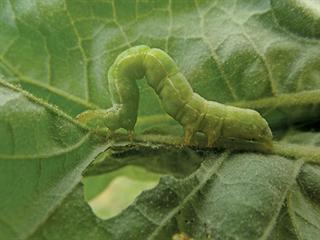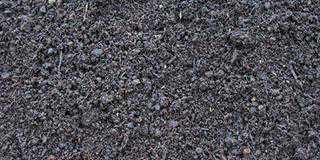
- Scientific name: Trichoplusia ni
- Family: Noctuidae
- Distribution: North America, parts of Africa and Europe
Description
The front wings have two silvery spots, one small and round, the other is U-shaped near the middle part. The hind wings are pale brown. Cabbage looper moths are strong fliers and primarily nocturnal. During the day, they rest among foliage or in crop debris. Young caterpillars are white and almost clear with a black head.Older caterpillars are green with a thin white line on each side and two other white lines on the dorsum.
They have three pairs of legs near the head and three sets of prolegs. They travel in a ‘looping’ manner, arching the middle portion of the body as they move forward. Fully-grown caterpillars reach 3cm to 4cm in length. Crops affected include cabbage, brassicas, tomatoes, lettuce, potatoes, sweet potatoes, cotton and beans. The caterpillar has been recorded on more than 150 species of plants.
Young caterpillars chew away at the leaves while larger ones feed on the tissue between the veins. A reduced ability to photosynthesise leads to defoliation, stunted growth and no head production. The caterpillar may bore into the heads of cabbages and other vegetables and contaminate them with frass (faeces), which can stain some plants.
Reproduction
The female lays a single egg, usually on the underside of a host leaf. It is about the size of a pinhead, rounded with a dome-shape, with ridges and is pearly-white in colour. It gradually darkens with age. Development from egg to adult takes about four to six weeks. Caterpillars hatch two to six days after the eggs are laid and go through five instars during development. Pupation occurs in a loose cocoon of silk attached to the underside of leaves, in a folded leaf or between two leaves. The pupa starts off green and turns dark brown. The moth emerges 10 to 16 days after pupation.
Control measures
Possibly the most effective chemicals are neem-based pesticides, which interfere with the growth of young caterpillars. Good control has been obtained with a 2% ethanolic extract of neem seeds (Ostermann and Dreyer, 2000).
Natural predators
The nuclear polyhedrovirus has been widely used in controlling this caterpillar. It occurs naturally in the soil or on plants. Virus-infected insects can be reintroduced by collecting diseased insects, macerating them in a blender, filtering out large tissue masses and then spraying the virus particles back onto the field.
Bacillus thuringiensis (Bt) products control the looper without harming natural predators. Treatments should be applied when caterpillars are small. Natural enemies such as parasitoids are usually proficient enough in their control, so that chemical insecticides is seldom warranted. Avoid using broad-spectrum pesticides so as not to disturb the balance of natural predators.
Cabbage looper infestations often increase after application as their natural enemies have been eliminated. This series is intended primarily as a guide to identifying pests. The control methods discussed are merely suggestions.
For help with area- or crop-specific measures, please consult your agricultural extension officer.
Paul Donovan, a Botswana-based biologist, promotes the use of biological control agents.













